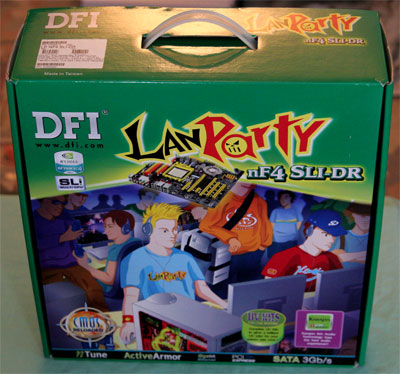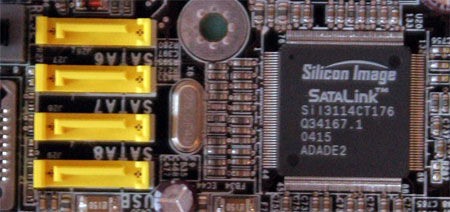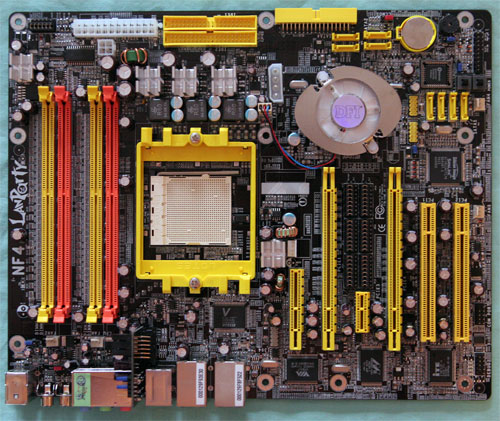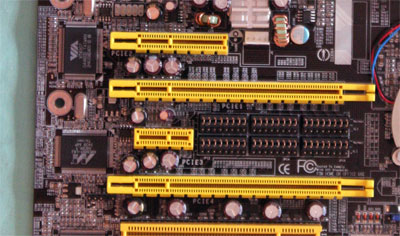nForce4 SLI Roundup: Painful and Rewarding
by Wesley Fink on February 28, 2005 7:00 AM EST- Posted in
- Motherboards
DFI LANParty nF4 SLI-DR: Features and Layout
| Specification | DFI LANParty nF4 SLI-DR |
| CPU Interface | Socket 939 Athlon 64 |
| Chipset | nForce4 SLI (single chip) |
| BUS Speeds | 200MHz to 456MHz (in 1MHz increments) |
| PCI/AGP Speeds | Asynchronous (Fixed) |
| PCI Speeds | 100MHz to 145MHz in 1MHz increments |
| Core Voltage | Auto, 0.8V to 1.55V in 0.025V increments (Normal) PLUS *104%, 110%, 113%, 123%, 126%, 133%, 136% (Special - to 1.85V) |
| CPU Startup Voltage | Startup, 0.825V to 1.550V in 0.025V increments |
| DRAM Voltage | 2.5V to 3.2V in 0.1V increments (3V jumper) 2.5V to 4.0V in 0.1V increments (5V jumper) |
| Chipset Voltage | 1.5V, 1.6V, 1.7V, 1.8V |
| Hyper Transport Ratios | Auto, 1.0, 1.5, 2.0, 2.5, 3.0, 4.0, 5.0 |
| LDT Bus Transfer | 16/16, 16/8, 8/16, 8/8 |
| LDT Voltage | 1.2V, 1.3V, 1..4V, 1.5V |
| CPU Ratios | Auto, 4x to 25x in 0.5x increments |
| Cool'n'Quiet MAX FID | Auto, 8.0 to 13.0 in 0.5x increments |
| DRAM Speeds | Auto, 100, 120, 133, 140, 150, 166, 180, 200 |
| Memory Command Rate | Auto, 1T, 2T |
| Memory Slots | Four 184-pin DDR Dual-Channel Slots Unbuffered ECC or non-ECC Memory to 4GB Total |
| Expansion Slots | 2 x16 PCIe Slots 1 x4 PCIe 1 x1 PCIe 2 PCI Slots |
| SLI Setup | Six 16-pin Jumper Blocks |
| Onboard SATA | 4-Drive SATA 2 by nF4 PLUS 4-Drive SATA by Sil3114 |
| Onboard IDE | Two Standard nVidia ATA133/100/66 (4 drives) |
| SATA/IDE RAID | 4-Drive SATA 2 PLUS 4-Drive IDE (8 total) Can be combined in RAID 0, 1 PLUS 4-Drive SATA by Sil3114 Sil3114 Raid 0, 1, 5 |
| Onboard USB 2.0/IEEE-1394 | 10 USB 2.0 ports supported nF4 2 1394A FireWire ports by VIA VT6307 |
| Onboard LAN | Dual Gigabit Ethernet PCIe by Vitesse VSC8201 PHY PCI by Marvel 88E8001 |
| Onboard Audio | Karajan Audio Module based on Realtek ALC850 8-Channel codec with 6 UAJ audio jacks, CD-in, front audio, and coaxial SPDIF In and Out |
| Other Features | Power and Reset momentary switches |
| BIOS | Award 2/17/2005 Release |
The DFI boards all support the full range of nVidia nForce4 features including nVRAID, Active Armor, SATAII 3Gb/s drives, NCQ, any-drive IDE/SATA Raid, PCIe Gigabit LAN by a PHY Ethernet chip (plus an additional PCI Gigabit LAN), and the nTune utility.
Packaging for the full LANParty nF4 SLI-DR is typical LANParty.

DFI has continued with the Karajan Audio Module first introduced on their LANParty 925x. As you will see later in our audio tests, the Karajan module was a much better performer than what we expected when we first saw the onboard Realtek 850 codec. We still wish that DFI had been able to use the High Definition ALC880 or a similar chip instead of the more common ALC850. However, the Karajan Module on the DFI SLI does provide the lowest CPU overhead that we have seen on any board using the 850.
The ALC850 Codec provides four pairs of stereo outputs, with 5-Bit volume controls and multiple stereo and mono inputs, along with flexible mixing, and gain and mute functions. Two 50mW/20ohm headset audio amplifiers are integrated at Front-Out and Surround-Out, and both amplifiers are selectable for Front-Out, Line-In and Mic-In as a Universal Audio Jack.
You can find more information on the ALC850 at Realtek.
DFI provides a full selection of rear I/O ports. These include 6 programmable audio mini jacks plus coaxial SPDIF in and out connectors to support the Realtek ALC850. The back panel also includes PS2 mouse and keyboard, 1 standard Firewire (IEEE1394a), 6 USB, and two RJ45 Gigabit Ethernet. There are no rear ports for a Parallel Printer or serial devices, but there is an onboard header for an external serial device an IR header.

The four DIMM slots support up to 4GB of up to DDR400 memory in a Dual-Channel memory configuration. Dual-Channel 1 is DIMMs 1 and 3, and Dual-Channel 2 is DIMMs 2 and 4. DFI specifies support for both ECC and non-ECC unbuffered memory. Contacts at DFI advise that best overclocking is achieved with the dual-channel DIMMs in Sockets 2 and 4.
Board Layout
The DFI LANParty nF4 SLI-DR is very well arranged, with almost everything located where it works best. As you will see if you study the layouts of the other SLI boards, the DFI differs substantially in layout.The DFI nF4 place the CPU in the top center of the board and DIMMs at the top. This arrangement worked well in our testing and should work better (for those who change memory frequently) than in the crowded right-hand alternate location used on many boards.

There is plenty of room around the Socket 939, so most Heat sink/Fans should work fine. A Zalman 7000 overhung DIMM slot 4, but it still cleared our stock OCZ memory and memory could work in all slots.
The IDE connectors are at our preferred upper right edge of the motherboard, and the floppy connector is a board edge connector located on the right edge around the middle of the board. Both locations worked well in our testing.


Asus A8N-SLI Deluxe: Overclocking and Stress Testing
DFI LANParty nF4 SLI-DR: Overclocking and Stress Testing










108 Comments
View All Comments
ajmiles - Wednesday, March 2, 2005 - link
If i was a doubting type I would suggest that Nvidia spent as much time tuning their drivers for benchmarks as they do games.Nice to see support for some unreleased games such as Battlefield 2 on the list though.
Wesley, you get my email btw? (sorry for bugging you)?
Wesley Fink - Wednesday, March 2, 2005 - link
nVidia has just advised the release of Beta 71.84 drivers now supporting 70 games in SLI. The drivers can be downloaded at http://www.nzone.com/object/nzone_downloads_rel70b... Below is a list of suypported games and benchmarks.Age of Mythology
AquaNox 2: Revelation
Armed & Dangerous
Battlefield 1942
Battlefield 2
Battlefield Vietnam
Breed
City of Heroes
Colin McRae Rally 2005
Colin McRae Rally 4
Conan
Dark Age of Camelot: Atlantis
Desert Rats vs. Afrika Korps
Dirt Track Racing 2
Doom 3
EverQuest
EverQuest II
Far Cry
Flat Out
Ground Control II : Operation Exodus
Half-Life 2
Halo
Hitman 2
IL-2 Sturmovik: Forgotten Battles
Joint Operations: Typhoon Rising
Kohan II: Kings of War
Leisure Suit Larry
Lineage II
Lock On
Lord of the Rings, Battle for Middle-earth
Madden NFL 2005
Max Payne 2
Medal of Honor
NBA Live 2005
Need for Speed: Underground 2
Painkiller
Perimeter
Prince of Persia: The Sands of Time
Quake III
Return to Castle Wolfenstein: Enemy Territory
Return to Castle Wolfenstien
Rome: Total War
Serious Sam: The Second Encounter
Sid Meier's Pirates!
Silent Storm
Sims 2
SpellForce
Splinter Cell
Splinter Cell: Chaos Theory
Star Wars Battlefront
Star Wars Jedi Knight: Jedi Academy
Star Wars Jedi Knight II: Jedi Outcast
Star Wars: Knight of the Old Republic
SWAT 4
The Chronicles of Riddick
Thief: Deadly Shadows
Tiger Woods PGA Tour 2005
ToCA Race Driver 2
Tomb Raider: The Angel of Darkness
Tony Hawk's Underground
Tribes Vengeance
Tron 2.0
Unreal
Unreal 2
Unreal Tournament 2003
Unreal Tournament 2004
Vampire: Bloodlines
Warhammer 40,000: Dawn of War
World of Warcraft
X2: the Threat
Xpand Rally
In addition to these top games, NVIDIA SLI supports the following applications:
3DMark01
3DMark03
3DMark05
AquaMark 3
Code Creatures
D3DRightMark
HDRLighting
NVIDIA Clear Sailing Demo
NVIDIA Dawn Demo
NVIDIA Nalu Demo
NVIDIA Timbury Demo
PCMark04
Shadermark 2.1
Trees of Pangaea
giz02 - Wednesday, March 2, 2005 - link
I've done some further testing, and still no luck. The PCStats review also indicated 192Khz output, but I can't find that either. I'm still hoping for something, and will let you guys know if anything comes up.Other points:
+ The onboard Creative can attenuate the digital outputs just like a regular live could. Most onboard solutions that i have used could not
- Cannot have Analog and Digital outs enabled at the same time (at least I haven't found that yet). All other onboard solutions that I have tried were able to do this. An example of what I'd like to do (ideally) is have my Zalman Real Surround headphones plugged in to the analog ports, and the z5500's plugged into the digital (coax/optical). When the GF complains, I could turn the z5500's off, and put on the headphones. With creative you do this BUT you also have to uncheck the digital out only box. If they can bot h be enabled at the same time, let me know (Y)
- Either the Z5500's can't accept 96/24 on the optical in, or the creative isn't outputting 96/24 on the optical out.
- Only Coax or Optical work at one time (with the Z5500's)
- DD and DTS passthroughs work with Videolan and DVD's/.ts's.
I'll try this board for a while longer, but if encode will not work, I'll be heading to DFI. It's a bit more expensive, but you get the Lan Tote (woohhoo!) and the extra PCIx slots. Anyone have any comments on DFI's onboard sound?
EODetroit - Wednesday, March 2, 2005 - link
Thanks giz02. One of these days some manufacturer is going to realize there's demand for this and meet it... I just hope that day comes sooner than later.SLK75 - Tuesday, March 1, 2005 - link
I bought the GA-K8NXP-9 because fo the rave reviews on its OC abilities which Anandtech also proved in their pre-production sample reviewed towards the end of last year...All of a sudden now Gigabyte's production version of the board does not seem to clock high as was expected and proved previously WHYYYY ???? and Anandtech make it really clear to Gigabyte that people went and bought their board not only first its great features but also for its OC capabilities...I hope Gigabyte can address this with a new BIOSgiz02 - Tuesday, March 1, 2005 - link
I feel DUPED by that PCSTATS review. I've asked the reviewer for why he indicated that the board can DICE (either how to do it, or who told him it was possible).The board is .... OK...
I'da rather had the DFI (if DICE is not possible!)
Aquila76 - Tuesday, March 1, 2005 - link
#89 - looks like we'll both still wait for the next SoundStorm. Maybe the next gen of PCI-E sound cards will have DDL?bob661 - Tuesday, March 1, 2005 - link
#89Thanks for the test.
giz02 - Tuesday, March 1, 2005 - link
So far, It's a negative on the DICE :(I have a single coax cable connected from the onboard card to my Z-5500's and they are not recieving Dolby on the speaker tests. Left and Right channels come through but that is is... 96-24 is working as well, but zilch on the 5.1 :(
1955mm - Tuesday, March 1, 2005 - link
#87: AMD has NOT made it clear that ECC is an Opteron only feature. Read the document from the link I posted. As for ASUS not supporting ECC, download the manual and look at pages 4-21 and 4-22. In the screenshot for DRAM configuration there is an item for ECC enablement. The ASUS K8N-E deluxe (socket 754) also supports ECC. If you still have doubts that the Athlon 64 supports ECC, go to crucial.com and see what memory is supported by the ASUS K8N-E deluxe and A8N-SLI deluxe. I think that you might be confusing registered memory with ECC. If you write code work with critical data ECC is worth having. I have had bad memory in the past that corrupted data without crashing the machine. Considering misinformation that is sometimes provided by motherboard manufacturers and your obvious confusion about the Athlon 64, I think that ECC deserves some mention by motherboard reviewers. I myself would like to understand why the A8N-SLI apparently supports 4 256MB ECC memory modules but not 2 512MB ECC memory modules (page 2-12 in manual), Wesley?